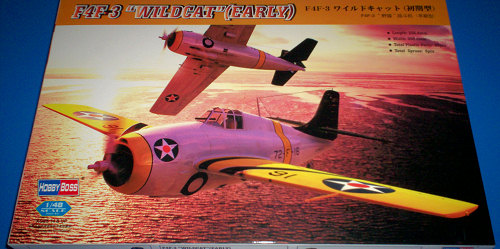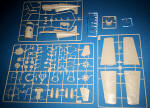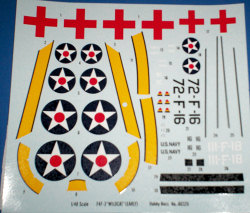
Hobby Boss 1/48 F4F-3 (early)
| KIT: | Hobby Boss 1/48 F4F-3 (early) |
| KIT #: | 80326 |
| PRICE: | $16.98 |
| DECALS: | Two options |
| REVIEWER: | Michael Koubek |
| NOTES: | A long waited early Wildcat in 1/48 scale |

| HISTORY |
The Grumman F4F-3 “Wildcat” was Grumman’s first monoplane fighter. It entered service with the US Navy in late 1940. By December 7, 1941, it equipped all but two Navy and Marine Corps fighter squadrons. It saw combat at Wake Island, early central Pacific raids, Coral Sea, Midway and Guadalcanal.
The F4F-3 went through many detail changes. It had three main production batches and a batch of the similar F4F-3A as well. Common to these variants was non-folding wings. However, there were smaller differences based on the production batch, involving engines, carburetor scoops, intercooler scoops, cowl flaps, windscreens, holdback fairings, etc. The subtypes used by the USN and Marine Corps:
F4F-3 “Early” or “Early Bird”
· BuNos to 1848 - 1896 and 2512 - 2538
· Built in 1940 & 1941
· Used the Pratt & Whitney R-1830-76 14 cylinder air cooled radial engine. This engine did not have magnetos on the crankcase.
· Cowling had external carburetor scoop at 12 o’clock position, single large flap on each side, and intercooler scoops at 4 and 8 o’clock positions. Note: some of the earliest Wildcat cowlings in this run had different panel lines, check your references for the plane you are modeling.
· Equipped with a telescopic gun sight when delivered, these were later replaced in the field with N2-A Optical sight when bullet resistant windshield retrofitted.
· Windshield side panels did not have an extra brace when delivered, but due to incidents of these collapsing, the brace was retrofitted.
· Some did not have the small teardrop shaped fairing just behind the cowl and just forward of the landing gear bay.
· Single beacon light on fuselage spine.
· Early style holdback at base of tail.
· Delivered in Yellow Wings scheme or overall silver lacquer with carrier tail color.
F4F-3A (a.k.a. Martlet III in British service)
· BuNos 3905 to 3969
· Built in 1941
· Used the Pratt & Whitney R-1830-90 14 cylinder air cooled radial engine. This engine did not have magnetos on the crankcase. Externally identical to -76 engine.
· Cowling had external carburetor scoop at 12 o’clock position, single large flap on each side, no intercooler scoops.
· Equipped with bullet resistant windshield.
· Windshield side panels did have extra brace when delivered.
· No intercoolers in wheel well.
· Single beacon light on fuselage spine.
· Early style holdback at base of tail.
· Delivered in overall “Neutrality” gray.
F4F-3 (late production)
· BuNos 3856 to 3874 and 3970 to 4057
· Built in 1941
· Used the Pratt & Whitney R-1830-86 14 cylinder air cooled radial engine. This engine did have magnetos on the crankcase. Same engine used on F4F-4 and FM-1
· Cowling had internal scoop, some single large flap on each side but most had eight small flaps (dash-4 had same flaps), and intercooler scoops at 4 and 8 o’clock positions.
· Equipped with bullet resistant windshield.
· Windshield side panels did have extra brace when delivered.
· Single beacon light on fuselage spine.
· Early style holdback at base of tail.
· Delivered in overall “Neutrality” gray.
F4F-3 (Final batch of 100)
· BuNos 12230 to 12329
· Built in 1943
· Used the Pratt & Whitney R-1830-86 14 cylinder air cooled radial engine. This engine did have magnetos on the crankcase.
· Cowling same as F4F-4: external scoop at 12 o’clock position, eight small flaps, and intercooler scoops at 4 and 8 o’clock positions.
· Windshield side panels did not have extra brace.
· Three lights on fuselage spine (same as F4F-4).
· Late style holdback at base of tail (same as F4F-4).
· Delivered in blue-gray over light gray
| THE KIT |
 Until
the release of the Trumpeter 1/32nd dash-3s, nearly all Wildcat kits
have been dash-4s. In 1/72nd scale, many companies produced dash-4s;
some have packaged them as dash-3s with conversion tips to backdate them.
Until
the release of the Trumpeter 1/32nd dash-3s, nearly all Wildcat kits
have been dash-4s. In 1/72nd scale, many companies produced dash-4s;
some have packaged them as dash-3s with conversion tips to backdate them.
Until now, the only way to model a 1/48th dash-3 was to backdate the Tamiya kit, or get an aftermarket resin conversion kit, which could be considerably more money than the kit itself. When Tamiya came out with their superb F4F-4, Wildcat fans hoped Tamiya would produce more Wildcat variants. Now finally, there is a dedicated 1/48th “early bird” Wildcat.
So what do we get in the box? A kit that looks very much like it is panographed down from the Trumpeter 1/32nd scale kits. The main sprues (wings, cowling, fuselage and smaller parts) are individually bagged. The two clear sprues are bagged together. It will allow you to model the “Early bird” Wildcat out of the box, or an F4F-3A with some modifications (more on that later).
The shape and outline exactly match the excellent 1/48 drawings in the Kagero Wildcat book. The wing panel lines are accurate, an area that is incorrect in most published drawings.
The panel lines are scribed, and all rivets indented. This is what we have come to expect from manufacturers, however this is not correct for the Wildcat. The F4F had many raised rivets, which Tamiya correctly depicted on their dash-4. This will not be of great importance to many modelers, as the difference after painting may not be very noticeable.
The cowling is correct for the first batch of F4F-3s.
The landing gear/engine bay includes some things that Tamiya left out: correct intercoolers, framing and oil tank. The engineering of the landing gear parts is very similar to that of Tamiya. The painting instructions call for the wheel bay to be painted silver, which would be correct for a “yellow wings” paint scheme. When the F4F-3A production started after the first batch of F4F-3s, this area was painted “Grumman” gray. This is very close to the light gray used on Vietnam era USAF undersides in the tactical schemes. This was continued on the remaining Grumman built Wildcats.
The landing gear is very fragile. It is well packaged with extra padding, but it is a challenge to remove it from the sprues without snapping anything (I found out the hard way). The panographing may be the culprit here, as Tamiya’s landing gear looks a bit beefier.
The engine crankcase is not correct for an early dash-3. The kit crankcase has the magnetos, which is correct the R-1830-86 used on the dash-4, FM-1 and the second and third batches of dash-3s. The cylinder rows are molded separately and include the pushrods, but no ignition wiring. Unlike the Tamiya kit, the crankcase does include the ignition wire harness.
The cockpit floor is correct; it allows one to look down to the fuselage windows. The cockpit wall with headrest (part F22) has the rod for the shoulder harness molded on. This should be removed for the first two production batches of the F4F-3, and the F4F-3A. The shoulder harness was introduced in during the production run of the F4F-4, in mid-1942. The instructions incorrectly call for using interior green on the cockpit. This should be bronze green, as only Wildcats built by Eastern Aircraft (FM-1 & FM-2) used interior green.
The kit provides the correct non-folding, 4 gun wing with gun barrels that extend from the leading edge. The panel lines are accurate for the dash-3. The holes for the guns are parallel to the wing; the inboard gun should be slightly higher. The aileron tabs are correct. Unlike the Tamiya F4F-4, the wings are molded separately from the lower fuselage, so care will have to be taken to ensure the correct dihedral.
The fuselage is a correct for the final 100 F4F-3’s (the cowl and canopy are not) and for the dash-4. It has the late model holdback at the lower tail and the extra spine lights.
The tail wheel is correct, but it depicts a pneumatic tire used for operating from land bases. The kit does not include have the smaller hard rubber tire which was used for carrier operations.
The clear parts are acceptably clear but a little thick. The windscreen is molded separately. It correctly has a hole for the telescopic gun sight. It has the side panel extra frame. This is correct for some aircraft and not for others, as it was added when some of the panels collapsed. Some of the “early bird” Wildcats had it, some did not. Check the aircraft you are modeling. The extra panel frame was standardized on the F4F-3 Late production and the F4F-3A. The extra frame itself is not placed in the correct position on the panel.
The kit comes with wing drop tanks, which you can add to your spares box. They were not used on F4F-3s. They are appropriate for F4F-4s, FM-1s and FM-2s.
The instructions use Gunze paints references, and use the color names in English.
This kit can be made into an F4F-3A by removing the cowling intercooler scoops, not including the intercoolers (parts F9 and F10) and using a modified Tamiya windshield. The F4F-3A was identical to the British Martlet III, so it is another option for the modeler. The instructions do not mention any of the modifications necessary to model the dash-3A.
Either
way, to correctly model the “early bird” dash-3, the holdback and spine lights
will have to be corrected. Consult period photographic references, as these are
often incorrectly depicted in many drawings of the F4F-3, and r estored
aircraft may have the holdbacks, cowlings or windshields updated later in their
service life.
estored
aircraft may have the holdbacks, cowlings or windshields updated later in their
service life.
Decals:
The decal sheet comes with a protective translucent sheet, sealed in its own clear bag. Two options are provided; the first for a “yellow-wings” F4F-3 section leader from VF-72 the USS Wasp, circa early 1941. The second is for an overall ‘neutrality’ gray F4F-3A from VMF-111 during the war games of 1941. There are two small errors on the sheet, the plane type has “F4F-34” (should be F4F-3A) and the service designator has “NAVY” when it should be “MARINES”. The decal sheet also includes some “nice to haves” like the correct Curtiss-Wright logos and red/yellow/blue tips for the propeller. The painting and decal placement guide is a separate color sheet.
| CONCLUSIONS |
It’s great to finally have a 1/48 scale early Wildcat. The markings/paint schemes range for this variant are plentiful: yellow-wings, overall gray, blue-gray over gray, tail red & white stripes, small or oversized insignia, etc. Is it as good as the Tamiya kit? No, but on a scale of ten, where the Tamiya kit is a 9.75, the Hobby Boss looks to be a solid 8. My trial fittings do not show any major problem areas. It should build to an attractive model.
HobbyBoss has also released an F4F-4, F4F-3 “Late” (correct for Butch O’Hare VF-3 decals so often seen), FM-1 and has announced an FM-2! Wildcat fans rejoice!
| REFERENCES |
Kagero #14 Grumman F4F Wildcat, Andre R. Zbiegniewski & Krzysztof Janowicz. ISBN 83-89088-53-3
Detail & Scale #65 F4F Wildcat in detail, Bert Kinzey. ISBN 1-888974-18-4
F4F Wildcat in action, Squadron/Signal Aircraft #191, Richard Dann. ISBN 0-89747-469-4
F4F Wildcat Walk Around, Squadron/Signal Walk Around #4, Richard Dann. ISBN 0-89747-347-7
The Wildcat Story: History of the Grumman F4F “Wildcat”, Grumman Aircraft Engineering Corporation, Frank L. Green (no ISBN, private publication of Grumman)
DVD Aircraft Films, F4F Wildcat
Kit courtesy of my wallet
If you would like your product reviewed fairly and quickly, please contact me or see other details in the Note to Contributors.